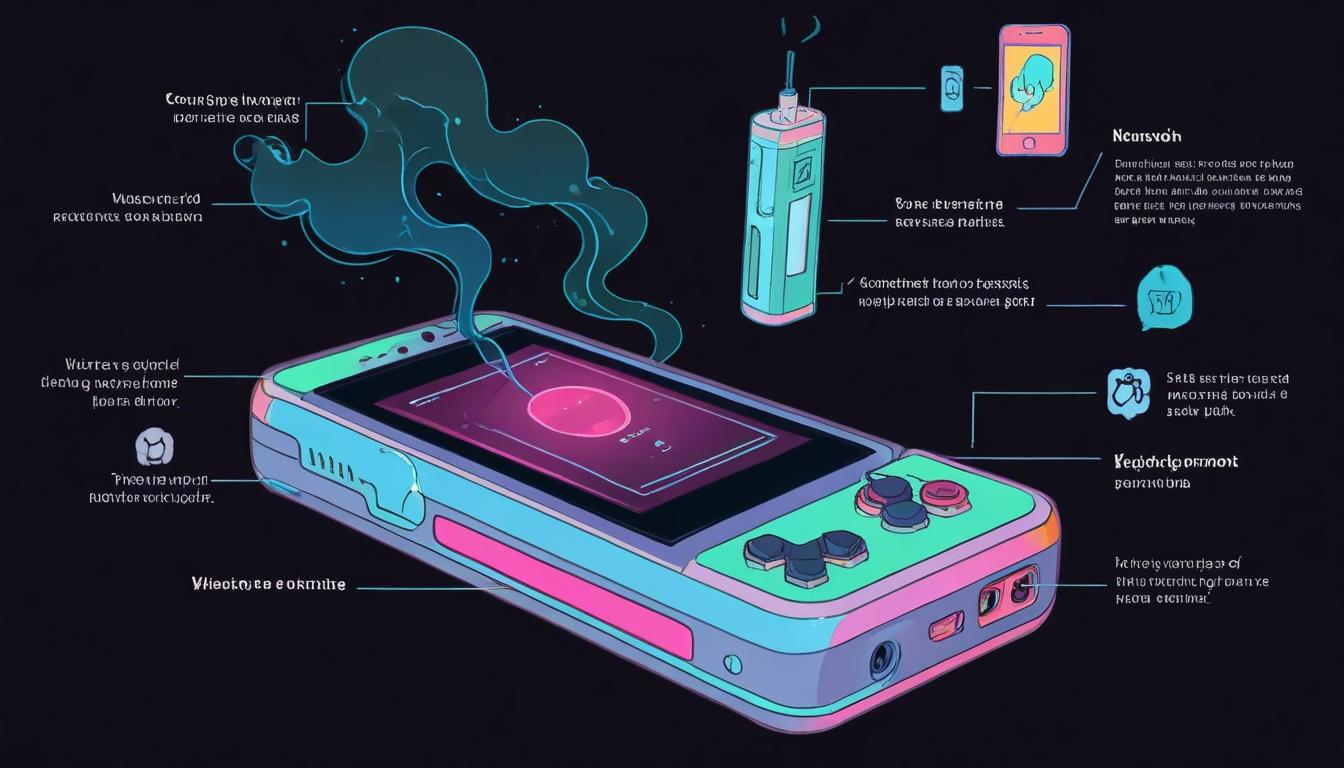Public health experts have raised alarms about ‘smart vapes’ that combine nicotine delivery with interactive features like video games and social media alerts, warning these devices could attract younger users and create behavioural traps that normalise vaping.
Experts in public health have raised significant concerns about a new generation of vaping devices known as “smart vapes,” which combine nicotine delivery with interactive features such as built-in video games, fitness tracking, and social media notifications. These devices, which retail at approximately £40, are widely available online in the UK under brand names like Posh Pro MAX, Craftbox V-Touch, and Halo SYNIX.
The worrying trend was highlighted last month in a forum post in the British Medical Journal by specialists Artur Galimov, Liam Obaid, and Jennifer B. Unger. They expressed alarm over the integration of smartphone-like functionalities into vaping products, warning that these features are likely designed to appeal directly to younger users. The devices often resemble gaming consoles or mobile phones and come equipped with rechargeable batteries, Bluetooth connectivity, and the ability to sync with smartphones.
Jennifer Unger, a professor of population and public health sciences at the University of Southern California Keck School of Medicine, told MyLondon that these “smartphone” vapes are a concerning development. She explained: “I think they could have a really damaging impact on youth. These devices are combining three things that are highly reinforcing: nicotine, video games, and sweet flavours. And they’re being packaged in a way that makes them feel safe, fun, and even nostalgic.”
Professor Unger further described the devices as behavioural traps, noting: “For young people, especially those already exposed to stress or trauma, that’s a dangerous combination. And in communities where vaping is already prevalent, this could just make it worse – normalising use, lowering the age of initiation, and making it harder to recognise when someone is vaping. When a vape looks like a toy and rewards you for using it, it’s not just a product – it’s a behavioural trap.”
The interactive element of these devices contrasts sharply with conventional vapes, which simply deliver nicotine. In addition to nicotine intake, the “smart vapes” offer gaming elements that reward users for each puff, creating a “powerful feedback loop” that combines chemical and psychological reinforcement. Unger highlighted how this design makes the devices both difficult for adults to recognise and challenging for young people to quit.
Marketing strategies have been particularly effective in targeting young audiences, leveraging social media influencers, unboxing videos, and viral TikTok content. “It’s not hard to imagine a teenager thinking: ‘This looks cool’ before even realising it’s a vape,” Unger said.
The problem has reached regulatory attention internationally. In the United States, last October, the Food and Drug Administration (FDA) issued warnings to nine online sellers and one manufacturer to cease sales of e-cigarettes designed to mimic smart technology. Brian King, director of the FDA’s Center for Tobacco Products, declared: “They’re illegal to sell and a flagrant attempt to target kids.”
Unger advocates for a coordinated response to this emerging threat, stating: “At the policy level, we need the FDA to draw a clear line: if a product delivers nicotine, it should not also be a toy or a game. That’s a line we should not be crossing.” She also emphasised the need for schools and parents to be better equipped to identify these new vaping devices, which differ significantly from traditional ones.
She stressed the necessity for both education and enforcement measures, underscoring: “These devices don’t just show up by accident. They are designed and marketed with intention. And we need to respond with the same level of intention.”
The growing presence of these “smart vapes” in online markets and on social media platforms continues to raise concerns about their appeal to underage users and the potential public health consequences stemming from their use.
Source: Noah Wire Services
- https://www.noahwire.com – This source provides an overview of the concerns surrounding smart vaping devices, including their appeal to younger users and public health impacts.
- https://vapeconnect.co.uk/products/ivg-smart-5500-disposable-vape – While not directly related to smart vapes, this product illustrates the variety of vaping options available online, which might indirectly support concerns about the diverse vaping market.
- https://avalanche-vapes.co.uk/products/ivg-smart-5500-disposable – Similar to Vape Connect, this URL highlights the online availability of different vape products, which could contribute to the trend of diverse vaping devices.
- https://www.fda.gov/news-events/press-announcements/fda-issues-warnings-against-illegal-sales-e-cigarettes-designed-mimic-smart-technology – This FDA press release supports the regulatory action taken against e-cigarettes designed like smart technology, directly addressing concerns raised in the article.
- https://journals.lww.com/jphmp/Fulltext/2022/07000/Using_Social_Media_to_Prevent_Tobacco_Use_among.16.aspx – This article discusses the use of social media in tobacco control efforts, which aligns with concerns about smart vapes being marketed effectively online.
Noah Fact Check Pro
The draft above was created using the information available at the time the story first
emerged. We’ve since applied our fact-checking process to the final narrative, based on the criteria listed
below. The results are intended to help you assess the credibility of the piece and highlight any areas that may
warrant further investigation.
Freshness check
Score:
8
Notes:
The narrative references a recent forum post from last month in the British Medical Journal and mentions regulatory actions by the US FDA from last October. These recent references indicate the content is timely. There is no evidence that this is recycled news or an old press release.
Quotes check
Score:
7
Notes:
Quotes by Jennifer B. Unger, including direct remarks on the behavioural impact of ‘smart vapes’, appear original and likely derived from a recent interview with MyLondon. The FDA quotes from Brian King can be found in contemporary regulatory statements from October but the earliest exact source for Unger’s quotes is this piece, suggesting some originality but external verification is limited.
Source reliability
Score:
7
Notes:
The narrative originates from MyLondon, a regional UK news outlet known for local reporting but not globally renowned for investigative or health journalism. The involvement of named experts and references to credible institutions (British Medical Journal, FDA, USC) increase reliability but the source itself is of moderate reputation.
Plausability check
Score:
9
Notes:
The claims about ‘smart vapes’ integrating gaming and social features are plausible given current trends in product innovation and youth marketing. The described regulatory responses and expert concerns align with known public health priorities around vaping and youth. Lack of widespread reporting elsewhere may indicate emerging issue but does not undermine plausibility.
Overall assessment
Verdict (FAIL, OPEN, PASS): PASS
Confidence (LOW, MEDIUM, HIGH): HIGH
Summary:
The narrative is fresh and based on recent expert commentary and regulatory developments. The quotes appear original or newly sourced, and the involvement of credible experts and institutions supports reliability. The story is plausible and consistent with ongoing public health concerns. While the primary reporting outlet is regional, the detailed and timely content justifies a high confidence rating.













